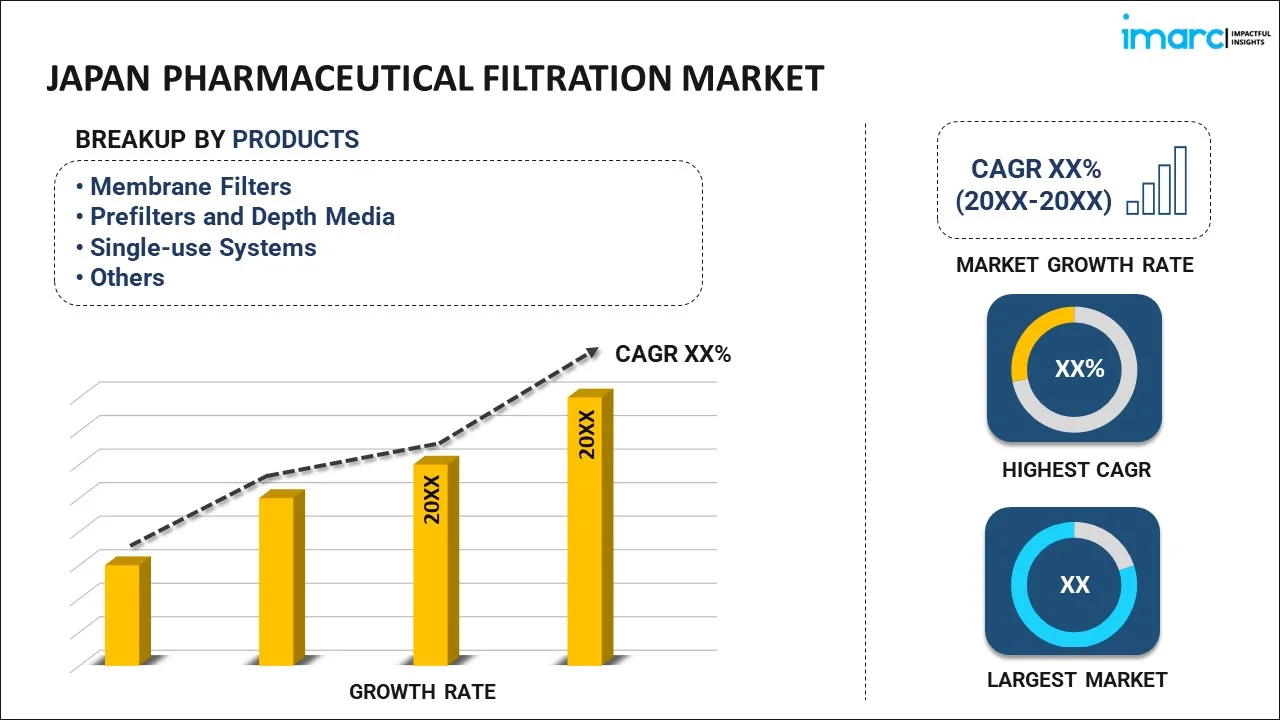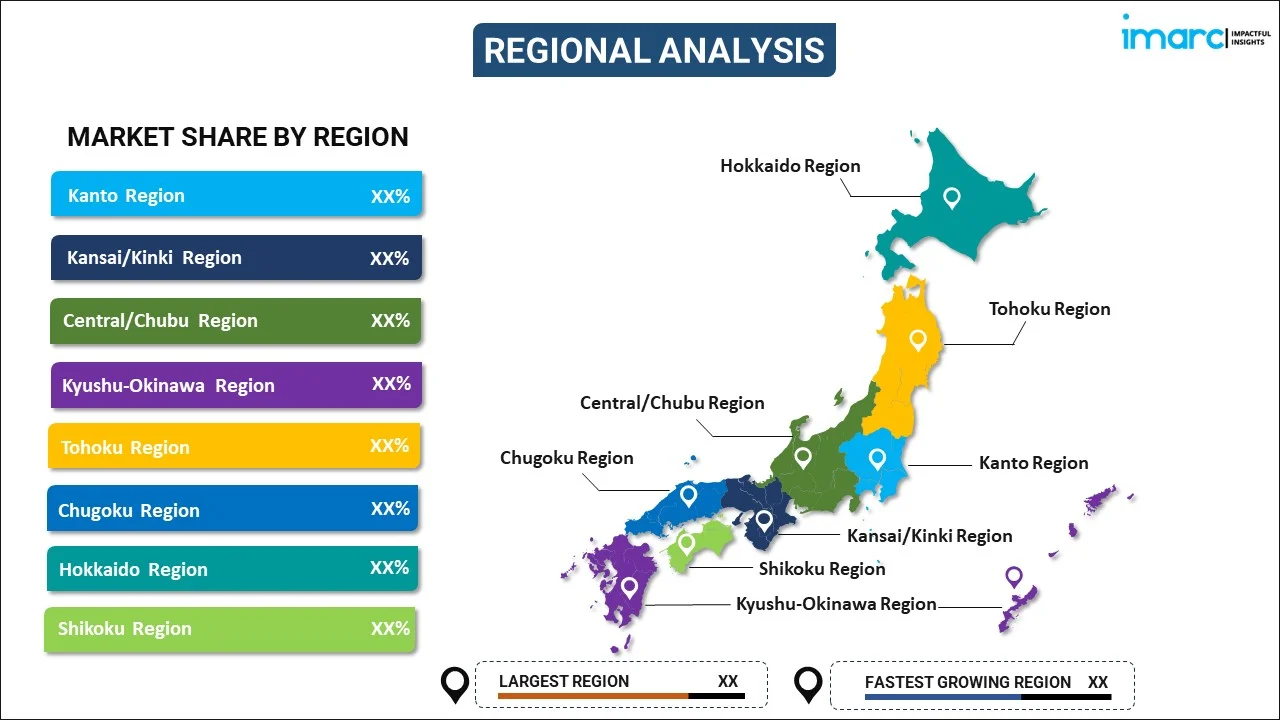
Japan Pharmaceutical Filtration Market Report by Product (Membrane Filters, Prefilters and Depth Media, Single-use Systems, Cartridges and Capsules, Filter Holders, Filtration Accessories, and Others), Technique (Microfiltration, Ultrafiltration, Crossflow Filtration, Nanofiltration, and Others), Application (Final Product Processing, Raw Material Filtration, Cell Separation, Water Purification, Air Purification), Scale of Operation (Manufacturing Scale, Pilot-scale, Research and Development Scale), and Region 2025-2033
Market Overview:
Japan pharmaceutical filtration market size reached USD 812.3 Million in 2024. Looking forward, IMARC Group expects the market to reach USD 2,382.6 Million by 2033, exhibiting a growth rate (CAGR) of 12.07% during 2025-2033. The implementation of stringent regulations by government bodies to ensure purity in the production of pharmaceuticals products is primarily driving the market growth.
|
Report Attribute
|
Key Statistics
|
|---|---|
|
Base Year
|
2024
|
|
Forecast Years
|
2025-2033
|
|
Historical Years
|
2019-2024
|
|
Market Size in 2024
|
USD 812.3 Million |
|
Market Forecast in 2033
|
USD 2,382.6 Million |
| Market Growth Rate 2025-2033 | 12.07% |
Pharmaceutical filtration involves the elimination of undesired particles or contaminants from medical products or their production environments through diverse filtration techniques. The primary aim is to eradicate impurities like microorganisms, particulate matter, endotoxins, and other substances that could jeopardize the pharmaceuticals' integrity and purity. This process holds a pivotal role in guaranteeing the safety, quality, and efficacy of pharmaceutical products. It is applied at multiple stages throughout the drug manufacturing process, encompassing the purification of raw materials, processing of intermediate products, and the final filtration of the end product. The choice of filtration methods varies based on the specific requirements of the pharmaceuticals industry.
Japan Pharmaceutical Filtration Market Trends:
The Japan pharmaceutical filtration market is experiencing substantial growth, propelled by a significant upsurge in the biopharmaceutical industry. Concurrently, the escalating prevalence of chronic diseases among the population is contributing to market expansion. Besides this, the increasing demand for parenteral drugs, injectable formulations, and aseptic processing underscores the need for reliable sterile filtration solutions, thereby driving the demand for high-performance filters and filter media within the pharmaceuticals sector, which is acting as another significant growth-inducing factor. Moreover, ongoing technological advancements in filtration, characterized by improved filter designs, innovative filter media, and advanced membrane technologies, are fostering the adoption of cutting-edge filtration solutions. These advancements offer notable advantages, including reduced processing time, improved product yield, and enhanced cost-effectiveness. Furthermore, the growing emphasis on single-use technologies is a catalyst for market growth, given the associated benefits such as reduced cross-contamination risks, simplified validation processes, and improved operational efficiency. Additionally, the increased adoption of innovative treatment therapies, including therapeutic proteins, monoclonal antibodies, and vaccines, has led to heightened utilization of filtration systems by biotechnology and biopharmaceutical companies. The confluence of these factors will position the Japan pharmaceutical filtration market at the forefront of advancements in the healthcare and biopharmaceutical sectors in the coming years.
Japan Pharmaceutical Filtration Market Segmentation:
IMARC Group provides an analysis of the key trends in each segment of the market, along with forecasts at the country level for 2025-2033. Our report has categorized the market based on product, technique, application, and scale of operation.
Product Insights:

- Membrane Filters
- MCE Membrane Filters
- Coated Cellulose Acetate Membrane Filters
- PTFE Membrane Filters
- Nylon Membrane Filters
- PVDF Membrane Filters
- Others
- Prefilters and Depth Media
- Glass Fiber Filters
- PTFE Fiber Filters
- Single-use Systems
- Cartridges and Capsules
- Filter Holders
- Filtration Accessories
- Others
The report has provided a detailed breakup and analysis of the market based on the product. This includes membrane filters (MCE membrane filters, coated cellulose acetate membrane filters, PTFE membrane filters, nylon membrane filters, PVDF membrane filters, and others), prefilters and depth media (glass fiber filters and PTFE fiber filters), single-use systems, cartridges and capsules, filter holders, filtration accessories, and others.
Technique Insights:
- Microfiltration
- Ultrafiltration
- Crossflow Filtration
- Nanofiltration
- Others
A detailed breakup and analysis of the market based on the technique have also been provided in the report. This includes microfiltration, ultrafiltration, crossflow filtration, nanofiltration, and others.
Application Insights:
- Final Product Processing
- Active Pharmaceutical Ingredient Filtration
- Sterile Filtration
- Protein Purification
- Vaccines and Antibody Processing
- Formulation and Filling Solutions
- Viral Clearance
- Raw Material Filtration
- Media Buffer
- Pre-Filtration
- Bioburden Testing
- Cell Separation
- Water Purification
- Air Purification
The report has provided a detailed breakup and analysis of the market based on the application. This includes final product processing (active pharmaceutical ingredient filtration, sterile filtration, protein purification, vaccines and antibody processing, formulation and filling solutions, and viral clearance), raw material filtration (media buffer, pre-filtration, and bioburden testing), cell separation, water purification, and air purification.
Scale of Operation Insights:
- Manufacturing Scale
- Pilot-scale
- Research and Development Scale
A detailed breakup and analysis of the market based on the scale of operation have also been provided in the report. This includes manufacturing scale, pilot-scale, and research and development scale.
Regional Insights:

- Kanto Region
- Kansai/Kinki Region
- Central/ Chubu Region
- Kyushu-Okinawa Region
- Tohoku Region
- Chugoku Region
- Hokkaido Region
- Shikoku Region
The report has also provided a comprehensive analysis of all the major regional markets, which include Kanto Region, Kansai/Kinki Region, Central/ Chubu Region, Kyushu-Okinawa Region, Tohoku Region, Chugoku Region, Hokkaido Region, and Shikoku Region.
Competitive Landscape:
The market research report has also provided a comprehensive analysis of the competitive landscape. Competitive analysis such as market structure, key player positioning, top winning strategies, competitive dashboard, and company evaluation quadrant has been covered in the report. Also, detailed profiles of all major companies have been provided.
Japan Pharmaceutical Filtration Market Report Coverage:
| Report Features | Details |
|---|---|
| Base Year of the Analysis | 2024 |
| Historical Period | 2019-2024 |
| Forecast Period | 2025-2033 |
| Units | Million USD |
| Scope of the Report | Exploration of Historical and Forecast Trends, Industry Catalysts and Challenges, Segment-Wise Historical and Predictive Market Assessment:
|
| Products Covered |
|
| Techniques Covered | Microfiltration, Ultrafiltration, Crossflow Filtration, Nanofiltration, Others |
| Applications Covered |
|
| Scale of Operations Covered | Manufacturing Scale, Pilot-scale, Research and Development Scale |
| Regions Covered | Kanto Region, Kansai/Kinki Region, Central/ Chubu Region, Kyushu-Okinawa Region, Tohoku Region, Chugoku Region, Hokkaido Region, Shikoku Region |
| Customization Scope | 10% Free Customization |
| Post-Sale Analyst Support | 10-12 Weeks |
| Delivery Format | PDF and Excel through Email (We can also provide the editable version of the report in PPT/Word format on special request) |
Key Questions Answered in This Report:
- How has the Japan pharmaceutical filtration market performed so far and how will it perform in the coming years?
- What has been the impact of COVID-19 on the Japan pharmaceutical filtration market?
- What is the breakup of the Japan pharmaceutical filtration market on the basis of product?
- What is the breakup of the Japan pharmaceutical filtration market on the basis of technique?
- What is the breakup of the Japan pharmaceutical filtration market on the basis of application?
- What is the breakup of the Japan pharmaceutical filtration market on the basis of scale of operation?
- What are the various stages in the value chain of the Japan pharmaceutical filtration market?
- What are the key driving factors and challenges in the Japan pharmaceutical filtration?
- What is the structure of the Japan pharmaceutical filtration market and who are the key players?
- What is the degree of competition in the Japan pharmaceutical filtration market?
Key Benefits for Stakeholders:
- IMARC’s industry report offers a comprehensive quantitative analysis of various market segments, historical and current market trends, market forecasts, and dynamics of the Japan pharmaceutical filtration market from 2019-2033.
- The research report provides the latest information on the market drivers, challenges, and opportunities in the Japan pharmaceutical filtration market.
- Porter's five forces analysis assist stakeholders in assessing the impact of new entrants, competitive rivalry, supplier power, buyer power, and the threat of substitution. It helps stakeholders to analyze the level of competition within the Japan pharmaceutical filtration industry and its attractiveness.
- Competitive landscape allows stakeholders to understand their competitive environment and provides an insight into the current positions of key players in the market.
Need more help?
- Speak to our experienced analysts for insights on the current market scenarios.
- Include additional segments and countries to customize the report as per your requirement.
- Gain an unparalleled competitive advantage in your domain by understanding how to utilize the report and positively impacting your operations and revenue.
- For further assistance, please connect with our analysts.
 Inquire Before Buying
Inquire Before Buying
 Speak to an Analyst
Speak to an Analyst
 Request Brochure
Request Brochure
 Request Customization
Request Customization




.webp)




.webp)












